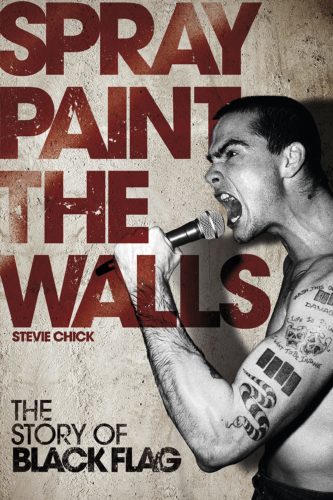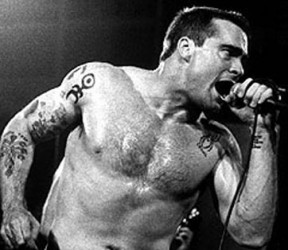Book Review: Raising the Black Flag
By Adam Ellsworth
There’s still an opening for someone to come along and write the final, definitive word on Black Flag. In the meantime, Spray Paint the Walls is a more than worthy placeholder and is highly recommended. It’s just not quite what it could have been.
 Spray Paint the Walls: The Story of Black Flag by Stevie Chick. PM Press, 432 pages, $19.95.
Spray Paint the Walls: The Story of Black Flag by Stevie Chick. PM Press, 432 pages, $19.95.
Barred for Life: How Black Flag’s Iconic Logo Became Punk Rock’s Secret Handshake by Stewart Dean Ebersole. Photographs by Jared Castaldi and Stewart Dean Ebersole. PM Press, 320 Pages, $24.95.
If relevance is measured in column inches, then Black Flag hasn’t had a year this good since the ’80s.
The hardcore pioneers are suddenly all over music websites and not in a retrospective, “Remember 1980s Punk,” way either. There’s genuine Black Flag news to report.
Like the fact that, confusingly, two separate versions of Black Flag are touring this year. And then there’s that brand new band related lawsuit floating around. But hey, all publicity is good publicity, right?
The Black Flag family tree has many, many branches, which is why it’s even possible for two versions of the band to tour at the same time. One version (which played Cambridge’s Middle East in June) is actually called Black Flag, and it features the band’s founder, guitarist, and main songwriter Greg Ginn, along with vocalist Ron Reyes. Reyes was Black Flag’s second lead vocalist and was initially in the band from 1979 to 1980 (and as such was featured with the band in the movie The Decline of Western Civilization and sang on the Jealous Again EP). The current group is rounded out by Dave Klein and Gregory Moore, neither of whom played with Black Flag during the band’s original go around.
The second touring version (which is coming to Paradise in Boston in September) is called FLAG and consists of Black Flag’s original vocalist Keith Morris, original, second, third, or fourth (depending on who you do or don’t count) bassist Chuck Dukowski, third vocalist and sometime rhythm guitarist Dez Cadena, fourth or fifth (depending on who you do or don’t count) drummer Bill Stevenson, and Descendants guitarist Stephen Egerton, who was never in Black Flag at all.
You may have noticed that Henry Rollins, the only former member of Black Flag that the average music fan has ever heard of, isn’t involved in any of this nor are more than a few other former members.
Confused yet?
Believe it or not, if you’d read Stevie Chick’s Spray Paint the Walls: The Story of Black Flag, you wouldn’t be. The book was published in 2011, so it doesn’t deal at all with these dueling reunions, but it does deal, in great detail, with the many lineup changes Black Flag went through in the ’70s and ’80s. Once you get your head around those changes, mastering the difference between Black Flag (2013 edition) and FLAG is a cinch.
The Black Flag saga is about more than changing lineups though, and Chick tells the tale completely through interviews with many of the major players, including Keith Morris, Ron Reyes, Chuck Dukowski, and (Dukoski’s replacement) Kira Roessler. He also interviewed other characters from the scene like Mike Watt of the Minutemen, founder of underground L.A. punk club the Masque Brendan Mullen, and photographer Glen E. Friedman, which adds some nice depth. Greg Ginn and Henry Rollins weren’t interviewed by Chick, but their voices are heard throughout the book thanks to the generous use of contemporary fanzine interviews and quotes from other books and magazines. New interviews with Ginn and Rollins certainly wouldn’t have hurt Spray Paint the Walls, but their absence leaves others more room to give their take. No one benefits from this more than Dukowski, who emerges from the book as the true spiritual center of Black Flag.
Vital as these interviews are, the book’s real strength comes from Chick’s use of research and his ability to place Black Flag’s story in a wider context. Whether he’s writing about surf culture, skate culture, or the history of garage rock, Chick does so with authority, and he braids these loose asides beautifully into the “facts” of Black Flag’s history. It seems obvious that a writer should do this, but too many don’t, and Chick deserves praise for pulling it off so well.
If the book has a flaw though, it’s Chick’s writing style, or lack thereof. Chick, who has also penned a book about Sonic Youth and has contributed to MOJO, the Guardian, NME, and other publications, is clearly a sound writer, and he never gets in the way of the story, both of which are preferable to their alternatives. But Spray Paint the Walls never sings, or even spurts. It reads more like a penultimate draft than a finished book. All the information (and then some) is there, and it is presented with authority. There are no major gaps and no grammatical errors. But . . . there’s also no polish. Where’s the electric language? Where’s the poetry? For a rock book to be placed in the pantheon alongside Shakey (a book Chick actually cites in Spray Paint the Walls and describes as “superlative”), The True Adventures of the Rolling Stones, or Mystery Train, the writing needs to match the brilliance of the subject. A high standard to meet, yes, and most books are far too flawed to even begin talking about the quality of the writing, but everything else about Spray Paint the Walls is so well done that it’s just begging to reach that next level. Unfortunately, it’s the lack of art in the writing that keeps it from getting there.
With this in mind, it seems there’s still an opening for someone to come along and write the final, definitive word on Black Flag. In the meantime, Spray Paint the Walls is a more than worthy placeholder and is highly recommended. It’s just not quite what it could have been.
The more recently published Barred for Life: How Black Flag’s Iconic Logo Became Punk Rock’s Secret Handshake doesn’t concern itself with the various incarnations of Black Flag or really even the band’s history at all. Instead, it seeks to illustrate, through striking black and white photography, the fact that an awful lot of people in the world have “The Bars” tattooed on their body.
The Bars. You’ve seen them, even if you have no idea what they mean. As the subtitle of Barred for Life says, they really are iconic. In the entire history of rock and roll, there is arguably no band logo more powerful and certainly no band logo that is both more powerful and more elemental. Four black rectangles. The end.
Those four rectangles derive their power from the fact that they don’t just stand for “Black Flag” but for a whole punk rock way of life, where you put your head down and bust your ass to work for what you want no matter the obstacle. Throughout the book, people from all over the world who have taken the extreme step of having The Bars tattooed on their arms, legs, lips, backs, necks, and fingers state that it’s in celebration of this sentiment that they got themselves “barred for life.”
The book’s author and mastermind Stewart Dean Ebersole traveled around the globe searching out inked folks so that he could (quite beautifully) photograph them and get their stories (Jared Castaldi also served as photographer). These photos and excerpted interviews form the heart of Barred for Life, and if the book had no other parts, then it would be a triumph. Unfortunately, there’s more to the book than these pictures and blurbs.
![Dan Habershaw -- the mystique of the [] tattoo](https://artsfuse.org/wp-content/uploads/2013/08/Dan-HabershawbyStewaD8F532-166x250.jpg)
In the history of rock and roll, there is arguably no band logo more powerful than four bars. Photo: Stewart Dean Ebersole.
But the real problem with Barred for Life is the narrative provided by Ebersole. Ebersole is not a writer, and as such it’s hardly fair to grade him on the same curve as Stevie Chick. He’s just a guy who had an idea, and he made that idea a reality. In that sense, he is the epitome of punk rock. The problem then is not Ebersole’s simple prose but the fact that he has completely missed an opportunity to really dive into the history of The Bars and their importance to Black Flag. In fact, when he does get to this point in his narrative, it’s already page 234! And even then, Spray Paint the Walls does a far better job than Barred for Life of explaining The Bars,and shedding light on the life and career of their creator, Greg Ginn’s brother, Raymond Pettibon.
Instead, Ebersole spends much of the narrative talking about his own story and how he got into hardcore and punk rock. This is informative in the sense that it mirrors the reasons that a lot of people got into hardcore and punk rock, but it takes forever! Ebersole’s personal history should be a chapter, stuck somewhere in the middle of the book and used only to highlight “how Black Flag’s iconic logo became punk rock’s secret handshake.” Moreover, just when you think that maybe the narrative is going to get good (again, starting around page 234), it devolves back into Ebersole’s story and, eventually, his journey around the world to photograph people with The Bars tattooed on their skin. His trip is best left to an introduction or prologue.
Neither Barred for Life nor Spray Paint the Walls then reaches its potential, though if one book comes out on top, it’s the latter. That one at least sniffs at greatness, while Barred for Life gives only a hazy look of what it could have been. If you do come across it though, check out the pictures. They’re superb.
Adam Ellsworth is a writer, journalist, and amateur professional rock and roll historian. His writing on rock music has appeared on the websites YNE Magazine, KevChino.com, Online Music Reviews, and Metronome Review. His non-rock writing has appeared in the Worcester Telegram and Gazette, on Wakefield Patch, and elsewhere. Adam has an MS in journalism from Boston University and a BA in literature from American University. He grew up in Western Massachusetts, and currently lives with his wife in a suburb of Boston. You can follow Adam on Twitter @adamlz24.


